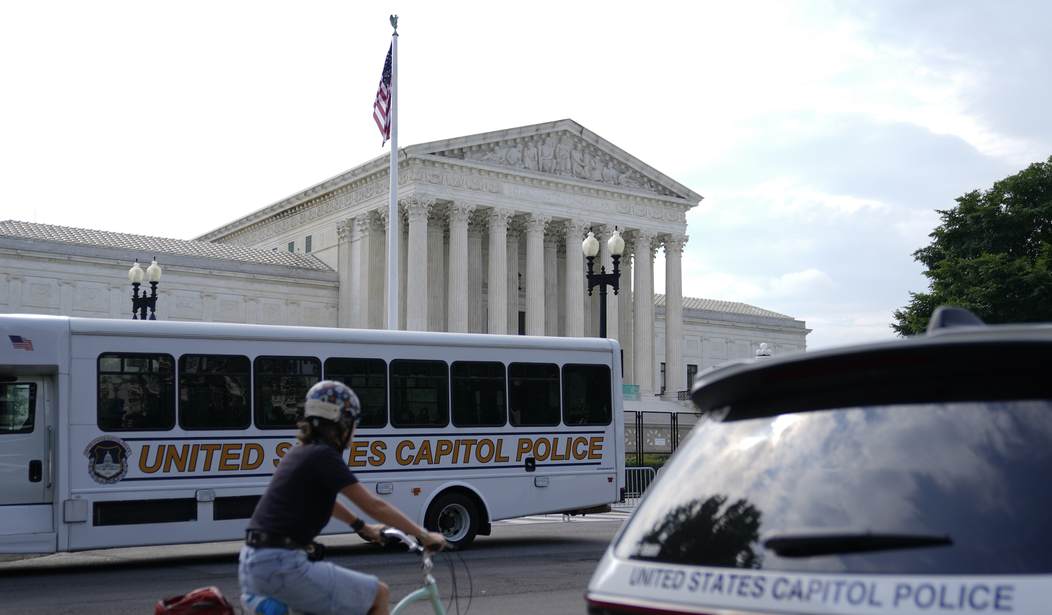Before yesterday, I’d have argued no. And frankly, even after my friend Glenn Reynold’s proposal at Newsweek to expand the Supreme Court to 59 members, I’d still say no. However, Glenn always offers an interesting argument, and I’d certainly agree with some of the principles on which this proposal is based.
Let’s start with resiliency, an issue that became acute after the leak of the Dobbs decision:
On a court with nine members divided 5-4 on many issues, you only have to get rid of one person. Especially when that person would be replaced by a president of the other party, as would have happened if Kavanaugh had been killed.
That’s too appealing a target for some of the crazies out there, especially when “respectable” people in the press and in politics are egging on the anger.
That certainly is true, and the crazies have discovered it. (Although to be fair, John Grisham’s The Pelican Brief covered this same territory in 1992.) However, that’s not the only institution that has a resiliency issue — so does the presidency. Four times in our history, a single assassin has changed the course of the nation, and others have tried as well. The last such attempt came in 1981, when Reagan survived an assassination attempt. We have not responded to this by turning the presidency into a committee, even though a real plot to kill both the president and vice president can hold the same potential to put the presidency into the hands of the opposing party, depending on the affiliation of the House Speaker.
The Supreme Court is already a committee of sorts, of course. Will an expanded membership make it more resilient while disincentivizing assassination plots to flip the court? Not if the system relies on the current president alone to appoint replacements, which Glenn recognizes. Hence, his call for a 59-seat Supreme Court, where each state appoints its own representative:
Nine Justices could be appointed by the president, as they are now. The additional 50 would come from the 50 states. Each state’s governor would nominate a member of the Court from his or her state, who would then be confirmed by the Senate as usual. (Although if you really wanted to go for a major change, the confirmation could be by the legislature of that state).
The increase in size would mean that changes due to death and retirement would be routine—no more bringing Washington to a halt every time a Justice retires. It would also remove some of the Court’s mystique. People might believe in nine philosopher-kings in a temple of justice, but no one would believe in 59 philosopher-kings. Fifty-nine sounds more like a legislature, and if the Court is going to do legislative-type things, as it clearly does, maybe that’s a good idea. …
And we’d probably also have a better Supreme Court. As my colleague Ben Barton argues in his new book, The Credentialed Court, today’s Supreme Court Justices are a bunch of academic and bureaucratic superstars who share similar backgrounds and attitudes even when they differ politically. Earlier generations of Justices had more varied backgrounds and more practical wisdom. Fifty Justices chosen by governors would probably look more like them than today’s judicial thoroughbreds.
That’s such a good idea, in fact, that the founders were way ahead of Glenn. His proposal reflects the Constitution’s foundation for the US Senate, which was supposed to be filled by appointees from state governments to represent their interests. The House was the People’s chamber, and the Senate was the states’ chamber, a structure that balanced the interests of both and tempered the reach of the federal government. The 17th Amendment destroyed that balance and made the Senate another vox populi instrument instead, which allowed for the rapid growth of the federal government at the expense of state governments that would have otherwise checked it.
Glenn’s proposal transfers that to the Supreme Court rather than the Senate. All that does, however, is ensure that state-government interests influence the rule of law by conceding the illegitimate legislative impulses at the Supreme Court. That’s an odd concession to make just after the Supreme Court finally signaled that it wants to move away from the legislative model by overturning Roe. We’re on the cusp of a judicial realignment to constitutional modesty that could undo some of the court’s previous mistakes, especially on the Interstate Commerce Clause and the reach of the regulatory state. Why legitimize the legislative impulse now, even tacitly?
We’d be better off repealing the 17th Amendment and returning the authority to name senators back to state governments on staggered calendars, as is the case now. (I’ve been wondering whether Glenn meant this as a wicked satire to make that very point, but let’s take it at face value.) That would ensure the proper balance of interests in Congress, and it likely would make senators more willing to work on solutions rather than conducting performance art on the Senate floor. If we did that and the Supreme Court returned to its proper constitutional role, we would likely have much less venom in our politics and especially in judicial confirmations.
That to me sounds like the conservative position — a way of conserving the institutions by returning them to their original constitutional purpose. To be fair, Glenn doesn’t propose this as a “conservative” idea, but rather a practical measure to deal with the current reality. It’s certainly provocative and interesting, but I’d make a point about practicality: how practical would it be to have 59 justices weighing in on cases, generating opinions, dissents, and concurrences? It sounds like a nightmare, not a practical or effective solution to a problem that may be solving itself already.
Glenn’s a brilliant writer and legal analyst, and this is a fun essay by which kick-start a debate, if nothing else. I’m still wondering if it’s a satire; is this *ahem* a Modest Proposal? Maybe, but then again, the best satire always leaves the reader wondering.









Join the conversation as a VIP Member